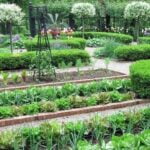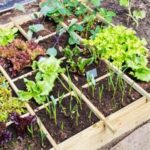Was 2019 a bad year for vegetable gardens in Ohio? Gardeners across the state faced numerous challenges as they worked to cultivate their crops. The weather, in particular, played a significant role in the success or failure of many vegetable gardens. In this article, we will explore the impact of weather conditions on vegetable gardens in Ohio, detailing specific challenges faced by gardeners and discussing potential coping strategies.
Ohio has a rich tradition of vegetable gardening, with many residents relying on their own homegrown produce for sustenance. However, the weather conditions in 2019 presented significant obstacles to successful gardening. Excessive rain, drought, and extreme temperatures all took their toll on vegetable gardens throughout the state. These factors affected not only individual gardeners but also commercial producers, highlighting the widespread impact of adverse weather on agricultural endeavors.
In addition to weather-related challenges, Ohio’s vegetable gardens also struggled with pests and diseases that further hindered crop growth and quality. This combination of factors led to crop failures and reduced yields for many gardeners. In the following sections, we will delve into the specific weather conditions and their effects on different types of vegetables grown in Ohio in 2019.
Weather Conditions in 2019
The weather conditions in Ohio during 2019 had a significant impact on vegetable gardens across the state. The year started with a particularly wet spring that delayed planting for many gardeners. Excessive rain led to waterlogged soil and hindered the growth of delicate seedlings.
Additionally, extreme temperature fluctuations throughout the summer months posed challenges for heat-sensitive vegetables such as tomatoes, peppers, and lettuces. In some regions of Ohio, drought conditions also prevailed during certain periods of the growing season, further complicating the efforts of gardeners.
According to meteorological data from the National Weather Service, Ohio experienced above-average rainfall in 2019, particularly during the spring and early summer months. From May to July alone, many areas in the state received between 10-15 inches of rain.
These excessive precipitation levels not only affected planting schedules but also increased the risk of diseases such as fungal infections and bacterial rots in vegetable gardens. On the other hand, some regions faced dry spells and insufficient moisture later in the season due to irregular precipitation patterns.
The unrelenting weather conditions of 2019 made it difficult for many types of vegetables to thrive in Ohio’s diverse climate zones. Crops like cucumbers and zucchinis were especially susceptible to disease outbreaks due to prolonged periods of high humidity caused by heavy rainfalls.
Conversely, root vegetables like carrots and radishes struggled with stunted growth because of inadequate water retention in drier areas affected by periodic droughts. Overall, Ohio gardeners encountered an array of challenges stemming from unpredictable weather patterns that influenced crop development throughout the year.
| Weather Condition | Impact on Vegetables |
|---|---|
| Excessive Rain | Delayed planting; waterlogged soil; increased risk of diseases |
| Drought | Stunted growth; inadequate water retention; susceptibility to pests |
| Extreme Temperatures | Challenges for heat-sensitive vegetables; fluctuations affecting crop health |
Crop Failures
Tomatoes
One of the most commonly grown vegetables in Ohio gardens, tomatoes experienced a particularly challenging growing season in 2019. The excessive rainfall early in the season led to issues with blossom end rot and other fungal diseases. Additionally, the fluctuating temperatures and humidity levels created an environment that was conducive to the spread of diseases like blight, resulting in poor fruit set and overall lower yields for many gardeners.
Zucchini and Squash
Zucchini and squash are typically prolific producers in Ohio gardens, but 2019 proved to be a difficult year for these vegetables. The excessive moisture and lack of sunlight due to overcast skies led to powdery mildew outbreaks, which significantly impacted plant health and fruit production. Many gardeners reported stunted growth and smaller harvests than usual as a result.
Peppers
Pepper plants struggled to thrive in Ohio’s 2019 climate due to the cooler temperatures during critical periods of flowering and fruit development. Many gardeners noticed slower growth and decreased yield, as well as an increase in diseases such as bacterial spot and early blight. The challenging weather conditions also affected pollinator activity, leading to poor fruit set for some varieties of peppers.
The challenges faced by these specific vegetables reflect the broader impact of the 2019 weather conditions on vegetable gardens across Ohio. Gardeners were forced to adapt their practices and expectations as they navigated through a growing season fraught with obstacles. However, despite these difficulties, many are hopeful for better outcomes in future seasons with the implementation of coping strategies and lessons learned from this experience.
Pests and Diseases
Common Pests
In 2019, Ohio vegetable gardens faced a significant challenge from various pests that affected the health and yield of crops. Common pests included aphids, caterpillars, spider mites, and beetles. These pests caused widespread damage to plants by feeding on leaves, stems, and roots, leading to stunted growth and reduced harvests for many gardeners.
Disease Outbreaks
Additionally, certain diseases became prevalent in Ohio vegetable gardens during the 2019 growing season. Fungal diseases such as powdery mildew and blight were particularly troublesome for tomatoes, cucumbers, and squash. Bacterial diseases also affected crops such as peppers and cabbage, causing wilting, rotting, and overall plant decline.
Challenges for Gardeners
The prevalence of pests and diseases posed significant challenges for gardeners across the state. Many struggled to keep up with pest management through natural remedies or organic pesticides while minimizing harm to beneficial insects. Additionally, combatting disease outbreaks required diligent sanitation practices to prevent the spread of pathogens within the garden.
While some gardeners were able to mitigate these challenges effectively, others experienced diminished yields or complete crop losses due to the impact of pests and diseases on their vegetable gardens. As a result, these issues contributed to the overall difficulty of gardening in Ohio during 2019.
Impact on Harvest
Weather conditions in Ohio during 2019 had a significant impact on the overall yield and quality of vegetable harvests. The excessive rainfall throughout the year led to waterlogged soil, affecting root development and causing rot in certain crops such as tomatoes and peppers. On the other hand, periods of drought in some regions of Ohio also affected vegetable gardens, leading to stunted growth and poor yields.
According to data from the Ohio State University Extension, some of the most commonly grown vegetables in Ohio saw a decrease in production compared to previous years. For example, sweet corn production decreased by 20%, while tomato and cucumber yields were down by 15% and 10% respectively. Additionally, many gardeners reported smaller sizes and lower quality produce due to the weather challenges faced throughout the growing season.
The impact of these weather-related issues wasn’t only felt by personal gardeners but also affected commercial farms across Ohio. Many farmers reported financial losses due to decreased yields and lower quality produce, which also had implications for consumers who rely on locally grown vegetables. As a result, there was an increased reliance on imported fruits and vegetables in grocery stores across the state.
| Vegetable | Decrease in Production |
|---|---|
| Sweet Corn | 20% |
| Tomatoes | 15% |
| Cucumbers | 10% |
Expert Insights
The challenging weather conditions in Ohio during 2019 had a significant impact on vegetable gardens across the state. Local farmers and gardening experts faced numerous obstacles while trying to cultivate their crops, leading to lower yields and decreased quality of produce. Despite these difficulties, there were valuable insights and experiences shared by those who worked tirelessly to overcome the challenges of the year.
Experts and farmers alike have identified several key factors that contributed to the struggles of vegetable gardening in Ohio during 2019:
- Unpredictable Weather Patterns: Many gardeners noted that the extreme swings in temperature, excessive rain, and unexpected droughts made it difficult to plan and maintain their crops.
- Pest Infestations: Insects and pests were particularly rampant during the 2019 growing season, causing damage to various vegetables and making it challenging to keep them healthy.
- Disease Outbreaks: Certain plant diseases were more prevalent than usual, affecting the overall health of vegetable gardens and requiring additional care and attention from growers.
Gardening experts provided valuable insights into how they navigated these challenges, offering tips on pest management, disease prevention, and weather-resistant crop choices. They emphasized the importance of resilience and adaptability in the face of adverse conditions, as well as maintaining open lines of communication with fellow growers to share knowledge and support each other through difficult times.
Coping Strategies
Ohio gardeners faced numerous challenges in 2019, from weather-related issues to pest infestations, which impacted the success of their vegetable gardens. However, there are strategies that can help mitigate these challenges and improve gardening outcomes in the future. Here are some tips and advice for Ohio gardeners:
1. Choose Resilient Varieties: When selecting vegetables to grow, opt for varieties that are known to be resilient in varying weather conditions. For example, consider planting drought-resistant tomatoes, disease-resistant cucumbers, and heat-tolerant peppers to increase the likelihood of a successful harvest.
2. Implement Water-saving Techniques: Given the excessive rain and drought experienced in Ohio in 2019, it’s important for gardeners to implement water-saving techniques such as drip irrigation systems, mulching, and rainwater collection. These methods can help maintain consistent moisture levels in the soil and reduce water waste.
3. Integrated Pest Management: To address pest infestations without relying heavily on pesticides, consider implementing integrated pest management (IPM) strategies. This approach involves using natural predators, companion planting, and trap crops to control pests while minimizing environmental impact.
4. Soil Amendment: Improving soil quality is essential for healthy plant growth. Conduct soil tests to determine nutrient deficiencies and pH levels, then amend the soil with organic matter such as compost or aged manure to provide essential nutrients for plants.
By implementing these coping strategies and adjusting gardening practices based on insights from local farmers and gardening experts, Ohio gardeners can overcome the challenges of 2019 and enhance their gardening outcomes in the future. As each growing season presents unique circumstances, being adaptable and making informed decisions can lead to more successful vegetable gardens in Ohio.
Looking Ahead
The 2019 gardening season in Ohio was undoubtedly a challenging one for many vegetable gardeners. The weather conditions, including excessive rain and extreme temperatures, posed significant obstacles to achieving successful harvests. As we look ahead to future gardening seasons, it’s important for Ohio gardeners to reflect on the lessons learned from the difficulties of 2019 and consider potential changes or adaptations to improve their gardening outcomes.
One key lesson from the challenges of 2019 is the importance of diversifying plant varieties in response to unpredictable weather patterns. Ohio gardeners should explore resilient and adaptable vegetable varieties that can better withstand fluctuations in temperature and moisture levels. Additionally, planting a variety of crops can help mitigate the impact of specific crop failures, ensuring a more reliable overall harvest.
In light of the prevalence of pests and diseases that affected vegetable gardens in 2019, Ohio gardeners may also want to consider implementing integrated pest management techniques and disease-resistant plant varieties in future gardening seasons. By taking proactive measures to prevent and manage pests and diseases, gardeners can minimize potential damage to their crops and promote healthier plant growth. Consulting with local agricultural extension services or experienced gardeners can provide valuable insights into effective pest and disease management strategies.
Conclusion
In conclusion, the weather conditions in Ohio in 2019 had a significant impact on vegetable gardens throughout the state. The excessive rain, drought, extreme temperatures, and prevalence of pests and diseases posed numerous challenges for gardeners, leading to crop failures and lower overall harvest yields. Despite these difficulties, it is important for Ohio gardeners to remain hopeful and motivated for future gardening endeavors.
Looking ahead, it is crucial for gardeners in Ohio to consider the lessons learned from the challenges of 2019 and make potential changes or adaptations for future gardening seasons. This may involve selecting more resilient vegetable varieties, implementing better pest and disease management strategies, and being prepared to adjust planting schedules based on weather forecasts.
While 2019 may have been a tough year for vegetable gardens in Ohio, it’s important to remember that each gardening season brings new opportunities for growth and learning. By staying informed about best practices, seeking advice from gardening experts or local farmers, and remaining flexible in their approach, Ohio gardeners can look forward to more successful and bountiful harvests in the years to come.

If you’re looking to get into vegetable gardening, or are just looking for some tips on how to make your current garden better, then you’ve come to the right place! My name is Ethel and I have been gardening for years. In this blog, I’m going to share with you some of my best tips on how to create a successful vegetable garden.





